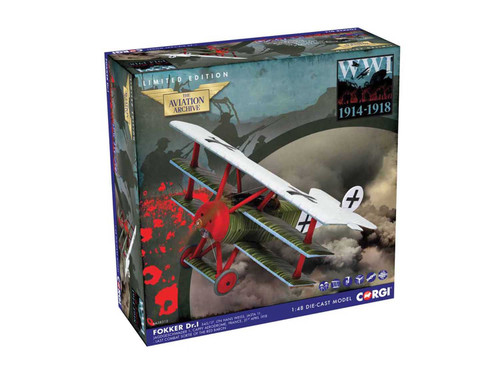Product Description
Product Info
Fokker E.III Eindecker, 105/15, Vfw. Ernst Udet, Germany, March 1916.
As the savage fighting on the Western Front revealed its insatiable appetite for consuming the lives of young men from all nationalities, a new war being waged in the skies above was about to take a similarly sinister turn. With their understanding of the absolute necessity to gain a control of the air and the wider implications this would have for the future of the entire conflict, the German High Command instructed its aircraft manufacturers to develop a new kind of aeroplane, one which was intended to hunt other aeroplanes and claim superiority of the skies.
The result of that search was the Fokker Eindecker, a mono wing fighter aircraft which represented the very pinnacle of aviation technology at that time, incorporating all the flight research data designers had managed to amass and utilising all the very latest technological advances in aviation. With the ability to fire its machine gun through the arc of the propeller by using a clever interrupter gear mechanism, all the pilot of an Eindecker had to do was to aim the nose of his aircraft in the direction of his target and fire, something of a revolutionary concept in aviation, but one which wasn't as simple as this description suggests.
It has to be remembered that the aeroplane was still in its relative infancy at that time and even though it was a technological marvel, the Eindecker was still rather primitive and relatively underpowered, making their pilots true pioneers in their craft. If they were competent enough to manoeuvre their aircraft into an attack position behind an enemy aircraft, the rudimentary wing warping flight control method could soon have them in trouble. If they let the thrill of combat overtake their judgement, a tight turn to stay on the tail of their intended victim could see them entering a dangerous spin, at best losing valuable altitude and the chance of gaining a victory and at worst, not stopping until the aircraft hit the ground.
Early Eindecker pilots were effectively writing the rules of aerial combat as they attempted to control the skies and with each hunting unit only usually being allocated three or four of the new fighters, they were still quite an exclusive group of airmen. Armed with their capable new aircraft, they learned quickly and Allied aircrews soon began to feel like they were nothing more than airborne prey.
With its position as the first true fighter aircraft in the world, the Eindecker is widely regarded by historians as the most influential military aircraft in the history of flight and even though the period referred to by the Allies as the 'Fokker Scourge' only lasted for a relatively short period of the war, the Eindecker had already made its significant contribution to aviation history. Relegated to non-combat and reserve roles by 1917, the Fokker Eindecker would also be used by the first fighter pilots of the Austro-Hungarian and Turkish air forces during the Great War.
Growing up in Munich, a young Ernst Udet was fascinated by the subject of aviation from an early age and would spend much of his free time doing whatever jobs he could at the local aircraft manufacturing company, whilst also helping to establish the Munich Aero-club. He was finally able to make his first powered flight with a test pilot from the aerodrome where he used to help out, but not before he had almost killed himself attempting to fly a glider he and his friends had built themselves.
Following the start of WWI, Udet applied to join the German Army, but standing just 5ft 3 ins tall was told that he didn't qualify. He would later use his motorcycle riding skills to gain a position in a military dispatch riding unit, but following an accident where he was thrown from the motorcycle as it ran over a shell crater, required a period of extensive recouperation.
During his return to health, Udet befriended some men who were assigned to a flying unit and convinced him to apply for pilot training, but after a couple of disappointments, discovered that the only way to guarantee acceptance in the Imperial German Air Service was to hold a civilian pilots licence. Immediately returning home and to the aerodrome where he had spent so many happy hours, a test pilot there agreed to teach him, but at his own expense and on receipt of his licence was finally successful with his application to join the Air Force. His initial posting was as pilot in a reconnaissance squadron, flying spotting and artillery ranging missions with his assigned observer and to say his service introduction was eventful would be something of an understatement.
He would be awarded the Iron Cross 2nd class for flying his damaged aircraft back to his home airfield following the failure of a wing brace anchor and with his observer on the wing, holding the wing together, but was later placed under arrest for recklessly overloading his aircraft with fuel and bombs when attempting to attack the enemy. When asked to observe an early bombing mission on his return to duty, where bombs were simply thrown from the cockpit of attacking aircraft, Udet impressed his commander by basically flying aerobatics in one of these primitive military aircraft, in an attempt to dislodge a bomb stuck in the undercarriage of his aircraft. On landing, he was immediately recommended for retraining as a fighter pilot.
Udet's introduction as a fighter pilot proved to be just as eventful as his reconnaissance posting. Flying a Fokker Eindecker, he chose to ignore combat instructions and attack a French aircraft head on and as the two aircraft closed at speed, Udet inexplicably froze. The French airman did not miss his opportunity and fired on the German aircraft, with a bullet grazing Udet's cheek and shattering his flying goggles, but failing to score a decisive victory.
Udet escaped this encounter relatively unscathed, but resolved to never give his opponent such a chance again and to always fly decisively and aggressively when in combat, perfecting his fighting style and to become an ace airman at the earliest opportunity. It is thought that Udet may have scored his first aerial victory whilst flying Fokker Eindecker E.III 105/15 in March 1916, the aircraft we have modelled here and on landing, he was immediately promoted to the rank of Vizefeldwebel.
Ernst Udet would quickly demonstrate his flying prowess and made good on the promise he made to himself. With his victory tally standing at 20, he was visited by a rather famous flying celebrity, a man who wanted him to join his celebrated Flying Circus, and when you are approached by a man such as Manfred von Richthofen, you definitely don't decline such an opportunity.
Having witnessed Udet shooting down an Allied artillery spotter during their first combat sortie, interestingly by performing a frontal attack similar to the one where he was almost killed, von Richthofen immediately gave his new recruit command of his old squadron, Jasta 11 and he would not regret the faith he showed in him. Udet would end the war with 62 confirmed victories, the most successful Great War air ace to survive the conflict and second only in number to the great von Richthofen himself.














